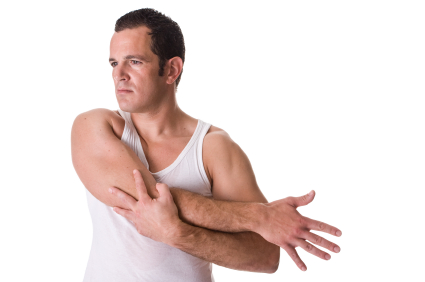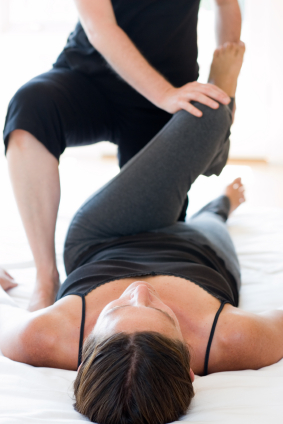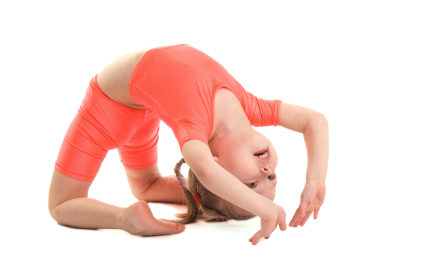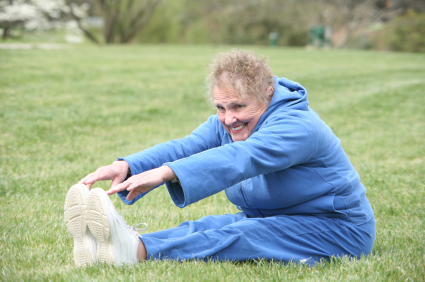 By David C. Simmons III
Flexibility Training
Stretching may not be at the top of the list before, during
or after
everybody’s workout, but It should be for many reasons.
Stretching refers to the process of elongation.
ROM "Range of motion"
ROM is how far a joint can be
flexed (bent) or extended (stretched).
Good "Range of motion" can mean
that a person can correctly perform a specific task like throwing a baseball, or
it can mean that the joint in question moves fluidly throughout its full range
of natural movement, like the forearm flexes fully up toward the shoulder from the
elbow joint and fully extends down away from the shoulder from the elbow joint.
So, basically, when you have good ROM, you have good FLEXIBILITY !
Here is a great link that shows what ROM looks like for several different
joints !
What limits flexibility.
Flexibility can be limited by genetics, previous injury
to the joint, elasticity (or lack of elasticity) of the tendons and ligaments, elasticity
of the muscle, ailments like arthritis, even neuromuscular coordination, swelling,
stiffness, pain and in short anything that inhibits the proper full ROM of a joint.
The greatest natural flexibility increases usually happen up to and between
7 and 12. After 25, aging can begin to change connective tissue and how far
limbs can be extended. .
Connective tissue begin to shorten and get tighter as we age. Even bad posture can
be the result of poor flexibility. Muscle imbalance can also happen because of lack of
flexibility.
It is interesting to note that a person can also be too flexible. This is
called hyper-flexibility. It can show itself as overstretched ligaments. This can be harmful as well and can be handled by strengthening
the muscles around the area. Even some Olympic athletes that depended on their flexibility to succeed,
have to keep their muscles strengthened because during their career, the muscles
around those ligaments were always kept strong..

Advantages of stretching and being flexible.
This
link show some disadvantages and advantages of stretching.
A good ROM causes the joint to use less energy
when it is in motion. Stretching also warms up tissue and increases nutrient flow.
Advantages of flexibility include:
Increased ROM.
Improved joint function.
Enhances muscle performance.
Prevents muscle injury especially during eccentric (lowering) exercise.
Helps prevent soft tissue injuries.
Decreases post-exercise soreness.
Allows more oxygen and nutrients to flow to the muscle cells.
Flexibility exercises.
Active ROM exercises are done by the individual alone. Active
assisted ROM exercises are done with a helper. Passive
ROM exercises are done by a helper to the client.
Here is a link that defines Active, active assisted and passive ROM exercise.
Under some
circumstances, stretching to much isn't good either.
And some people can perform
certain activities better with shorter muscles (section
3 last paragraph - a bit complicated, but oh well, its a reason).

Including flexibility exercise as part of your workout session
Another way to include flexibility exercise in your workouts is to do them
between sets. One name for doing this is "Active Rest". If you are doing pushups,
then you can stretch your abdominals and/or back between your pushup
sets. If you are doing
squats you could stretch your calves, thighs (hamstrings and/or quadriceps) between your squat sets. Stretching between sets can also reduce muscle soreness later.
 One of the most beneficial times to perform flexibility
exercise is after your regular workout when your muscles are warm, this is when they are most pliable
and ready to be pulled or lengthened a bit. But, even
though it may sound like the opposite, some may need to perform a cool down before
stretching so that if they lay down while stretching there heart rate is below 100.
Having your head below your heart accompanied by breathing slow can cause nausea,
dizziness and even fainting, so always cool down before stretching, your muscles
will still be warm enough to get the benefit. Now, muscles DO NOT NEED TO BE WARM to
stretch. You can stretch in front of the T.V., even in bed when you first wake up.
One of the most beneficial times to perform flexibility
exercise is after your regular workout when your muscles are warm, this is when they are most pliable
and ready to be pulled or lengthened a bit. But, even
though it may sound like the opposite, some may need to perform a cool down before
stretching so that if they lay down while stretching there heart rate is below 100.
Having your head below your heart accompanied by breathing slow can cause nausea,
dizziness and even fainting, so always cool down before stretching, your muscles
will still be warm enough to get the benefit. Now, muscles DO NOT NEED TO BE WARM to
stretch. You can stretch in front of the T.V., even in bed when you first wake up.
For Flexibility training, one of the strategies I use
with my clients is to first decide on the joint of the body that is either a problem
area when it comes to ROM, or, an area where more ROM is desired. Then I like to
find 2 or 3 (to hit the joint from more than one angle) flexibility exercises for
that joint that move the joint in the desired direction. I concentrate on the same
2 or 3 joints for a few sessions. It is important to know that a stretch should be
held for 15-30 seconds as a general rule of thumb.
Some say It is wise to always stretch two times per day. It may seem
like a lot, but it helps hold your flexibility gains. It makes sense to get the
muscles stretched when I first wake up and then again before I go to bed so I don't
go to sleep with tight muscles. I have also heard that stretching a tight
muscle once is sufficient because any more than that gives little benefit. I was
taught to stretch 2-4 times. My conclusion is that it depends on your body science.
Once may not be enough.
There are times when a full session needs to be devoted to stretching
alone ! My new client Brand is about to get a full dose of this when we begin his
sessions. This involves deciding on 5 or 6 joints or movements that need increased
ROM, and focusing on those. I concentrate on active stretches, those that can be
done by the individual when they are alone. This also teaches the client
stretches they can do on their own. However, sometimes I employ "Active
assisted" stretches in situations where the stretch cannot be done by the individual,
but the joint can be stretched further without pain or injury.
Some dynamics of stretching.
Some say connective tissue is a combination of 2 mechanical
properties - elasticity and viscosity. Makes me think of silly putty when its cool.
There is an elastic stretch which makes the tissue return to is original
form and a plastic stretch which causes the tissue to come back almost to its normal
form. The plastic stretch is what most of us are after, so, I will only address
this plastic stretch here.
To get this plastic stretch, you can use what's called a "static" stretch.
With slightly elevated tissue temperature, this is a low force, long duration stretch.
Static stretches are the way to go.
However, here is a link to an article
that says static stretching before certain activities like sports can cause problems
(its a ways into the article, but worth finding).
Stretching for to long a time or to vigorously is not good either. Because when connective tissue is stretched, molecules of the tissue being stretched
become temporarily
reorganized.
This makes the tissue weak for a short time, but it adapts soon after stretching. But while your digesting that,
here is a link that
talks about a study done on how long to stretch.
Muscles are protected from sudden over stretching by neural receptors
called
muscle spindles. These spindles lay parallel to muscle fiber and once too
much stretch or to vigorous a stretch is encountered, the spindles relay a signal
to the brain and the brain signals back a message for the associated muscle to give
a sudden protective contraction. However, to much of a quick and extreme movement
overrides this muscle spindle nerve reaction and injury can result.
This is a great link about the PYSIOLOGY OF STRETCHING. You have got to see
this !
Basic stretching guidelines (basic rules of thumb, without the
different opinions):
Here is a link that shows why and how to do basic stretches.
This next link talks about runners getting injured because
they don't stretch and also, because they do - huh ?
Static stretch 15-30 seconds before activity after you
warm up your muscles.
Static stretch 15-30 seconds (30 is best) when muscles
are warm after exercise..
Muscles do not need to be warm to perform stretches, its just best.
Experts say you should stretch both before and after exercise,
but for different reasons.
Stretch before exercise to decrease muscle stiffness. The areas stretched
depend on the activity you are about to perform.
Stretch after exercise because the muscles are warm and are pliable
and ready to be elongated. Stretching after also helps remove waste accumulated
during exercise and increases circulation.
Stretching should be done for 15-30 seconds, 2-4 times (sets).
Let your heart rate slow to under 100 beats per minute. Having your
head below your heart when your heart rate is to high, accompanied by breathing slow can cause nausea, dizziness and
even fainting, so always cool down before stretching, your muscles will still be
warm.
Here is a link about stretching for woman (guys, you need some of this
as well)
|
Flexibility Training.
A Body Science - We will help you to use Flexibility Training as a strategy.
- Identify the areas where you need flexibility the most:
-
- Areas that are stiff.
- Increase flexibility in areas where you want to increase strength.
- Duration - Length of time you should do your cardio
- Which stretches to do during other exercises
- Help you know which flexibility exercises you should do at home:
-
- How often and for how much time.
- Type of stretch for specific muscles where you are inflexible.
- What you can use at home to help you stretch (walls, mats, furniture etc)
- Proper stretching technique:
-
- Help you know when to use dynamic vs. static stretching.
- Stretching with or without assistance.
- And More !!
|
More research on flexibility will be available soon !
|